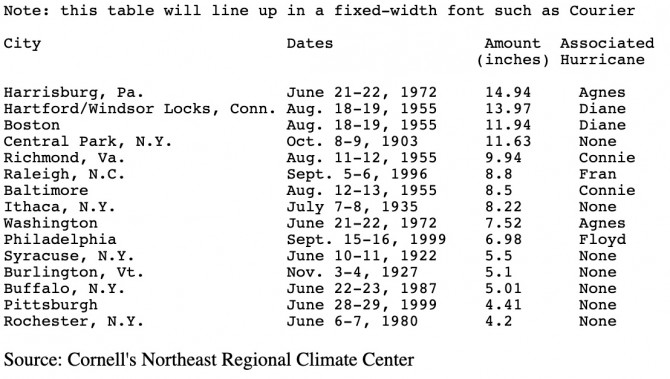Weakened Hurricane Isabel will drop its heaviest rain on Northeast, Cornell climatologist predicts
By Blaine Friedlander
As Hurricane Isabel churns in the middle Atlantic and takes aim at the East Coast, the storm's track on Thursday night and into Friday morning lies directly through the heart of the Northeast, where it is likely leave heavy rains and strong wind in its wake.
Hurricanes and tropical storms, weakened as they passed over land, have caused some of the greatest two-day rainfall totals in the Northeast, say experts at Cornell University's Northeast Regional Climate Center (NRCC). Hurricane Agnes dumped 14.94 inches of rain on Harrisburg, Pa., on June 21 and 22, 1972, and a two-day record 7.52 inches of rain on Washington, D.C., on the same dates. On Aug. 18-19, 1955, Hurricane Diane dropped 13.97 inches of rain on Hartford/Windsor Locks, Conn., and 11.94 inches of rain on Boston.
Isabel, a Category 2 hurricane, is aimed at Richmond, Va., and is expected to pass east of Pittsburgh and move north to Rochester, N.Y. As it travels over land, the winds will certainly abate, says Arthur T. DeGaetano, Cornell associate professor of atmospheric sciences and the director of the NRCC. "We're certainly going to have strong winds, but as it moves into the Northeast, we could also see a lot of rain," he says.
At 5,000 feet above the ground, the winds are predicted to be 75 mph, says Mark Wysocki, Cornell senior lecturer in meteorology. At ground level, Wysocki says to expect sustained winds at around 40 mph and gusts close to 50 mph as the storm moves through the Northeast.
The storm is expected to track through the heart of Virginia, the eastern panhandle of West Virginia, western Maryland, central Pennsylvania, into central and western New York, then into Ontario. However, Wysocki believes that the Blue Ridge Mountains in Virgina and the Allegheny Mountains in Pennsylvania will slow the storm's wind speeds. "The mountains are surface friction, like teeth breaking food up," he explains. "Still, winds will be strong all day Friday."
In the Northeast, winds usually originate from the west and southwest, while this storm will bring winds from the south-southeast and east. Wysocki worries about weak tree branches knocking out power. He says: "The trees are still recovering from the winter storms, and many limbs and trees are weak. This storm could be all it takes to bring them down."
Greatest two-day precipitation totals in major cities in the Northeast and Middle Atlantic states
Media Contact
Get Cornell news delivered right to your inbox.
Subscribe